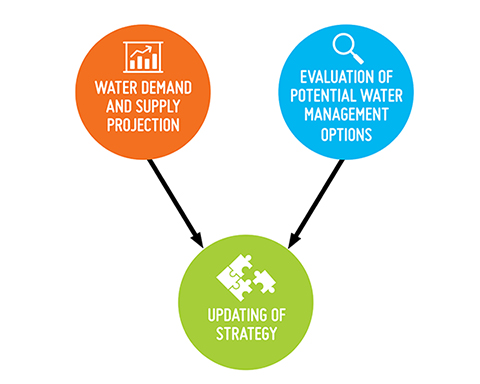
The Strategy, which was promulgated in 2008, has been overall effective. However, in face of contemporary challenges of population and economic growth, climate change as well as keen competition in the Pearl River Delta on water resources, the Review updated the forecast methodologies of water demand and supply and projections up to 2040 and sought for new water management initiatives and adjustments to the existing measures if necessary for ensuring the long-term sustainability of water supply in Hong Kong.

The water demand projection is estimated based on the baseline population projection of 8.2 million by 2040 provided by the Census and Statistics Department. Under this expected population growth scenario, the annual fresh water demand is projected to increase to 1,110 mcm in 2040, in the absence of water demand management measures.
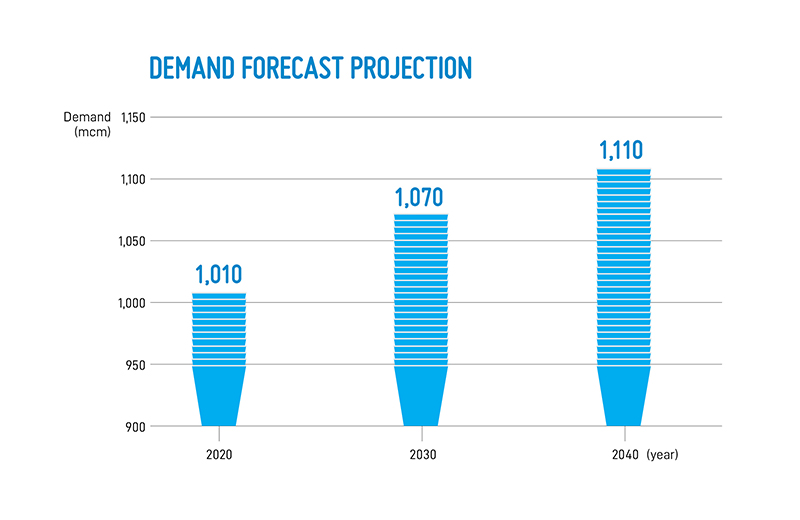
Local yield is the rainwater collected from water gathering grounds in Hong Kong. The water supply projection of our local yield is based on the projected rainfall under the scenario analysis of different national emission reduction scenarios in relation to the pledges agreed at the Paris Climate Conference in 2015. If all the national emission reduction pledges materialise, the medium-low and medium-high scenarios of greenhouse gas concentration scenarios would be more likely to happen with corresponding impact on the global climate. Under these scenarios, the mean of annual rainfall in Hong Kong in the next couple of decades is likely to be slightly lower than the average annual rainfall during the period of 1986-2005. However, given that there are also some experts expressing uncertainty in achievement of the reduction pledges eventually, a prudent approach is adopted to consider the plausible extreme climate change effect by including all climate change scenarios in an envelope to cater for the lower bound of the projected effect on annual rainfall8 in the evaluation of climate change effect on local yield.
The consultants have developed a yield model to forecast the local yield from our water gathering grounds. Under the projected mean rainfall of the medium-low and medium-high climate change scenarios, the reliable local water supply9 will remain more or less the same as the historical long-term average. However, under the lower bound of the envelope of projected effect on annual rainfall of all climate change scenarios, the reliable local water supply may decrease by about 50mcm.
Having projected the water demand and supply in the future, we need to implement water management measures to ensure sustainability of water supply in Hong Kong. In the following paragraphs, an evaluation for selecting and prioritising the potential options of water management measures is introduced.
To proceed, we need to set the scene for the evaluation by establishing a supply baseline. The consultants have adopted the current water supply portfolio of three water taps, namely the local yield, Dongjiang water imported from the Guangdong Province and seawater for flushing, as the baseline. International experts from the consultants considered that the current fresh water supply arrangement (i.e. local yield together with guaranteed Dongjiang water supply with a ceiling of 820 mcm per annum) should be reasonably set as the baseline condition and it is an optimal arrangement which has secured water supply reliability of 99% for Hong Kong, such that water supply can be maintained round-the-clock even under extreme drought condition with a return period of one in 100 years. The current water supply system in Hong Kong has the infrastructures for water transfer and treatment built in place already to cater for Dongjiang water supply ceiling of 820 mcm per annum. Reduction of the supply ceiling will lower the utilisation of the existing system and on the other hand require additional investment in implementation of other water supply facilities to make up the reduced Dongjiang water supply and such proposal is thus not cost-effective. On the contrary, further increase in Dongjiang water supply ceiling will mean additional charges for purchasing that quantity of water above the current supply ceiling and additional investment in infrastructures for transfer and treatment of the increased Dongjiang water quantity. The cost-effectiveness for the increase in Dongjiang water supply ceiling need to be evaluated in comparison with other water supply management options.
The Review has carefully evaluated the water demand and water supply management options using an approach named "Multi-Criteria Evaluation". First, against the backdrop of the existing supply arrangement of Dongjiang water supply together with local yield as the baseline, the consultants identified options in water demand and water supply management and shortlisted a number of options on the basis of technical viability, land requirement, environmental impact, etc. A panel of international experts of the consultants evaluated and scored the shortlisted options under the three sets of criteria: resilience, economics and sustainability. Based on the combined score of each shortlisted option, a prioritised list of the shortlisted options is drawn up. In reviewing the Strategy, we have engaged the Advisory Committee on Water Supplies and stakeholders, and have also taken into consideration the views collected.
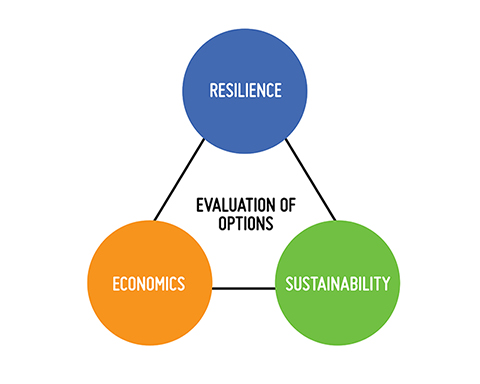
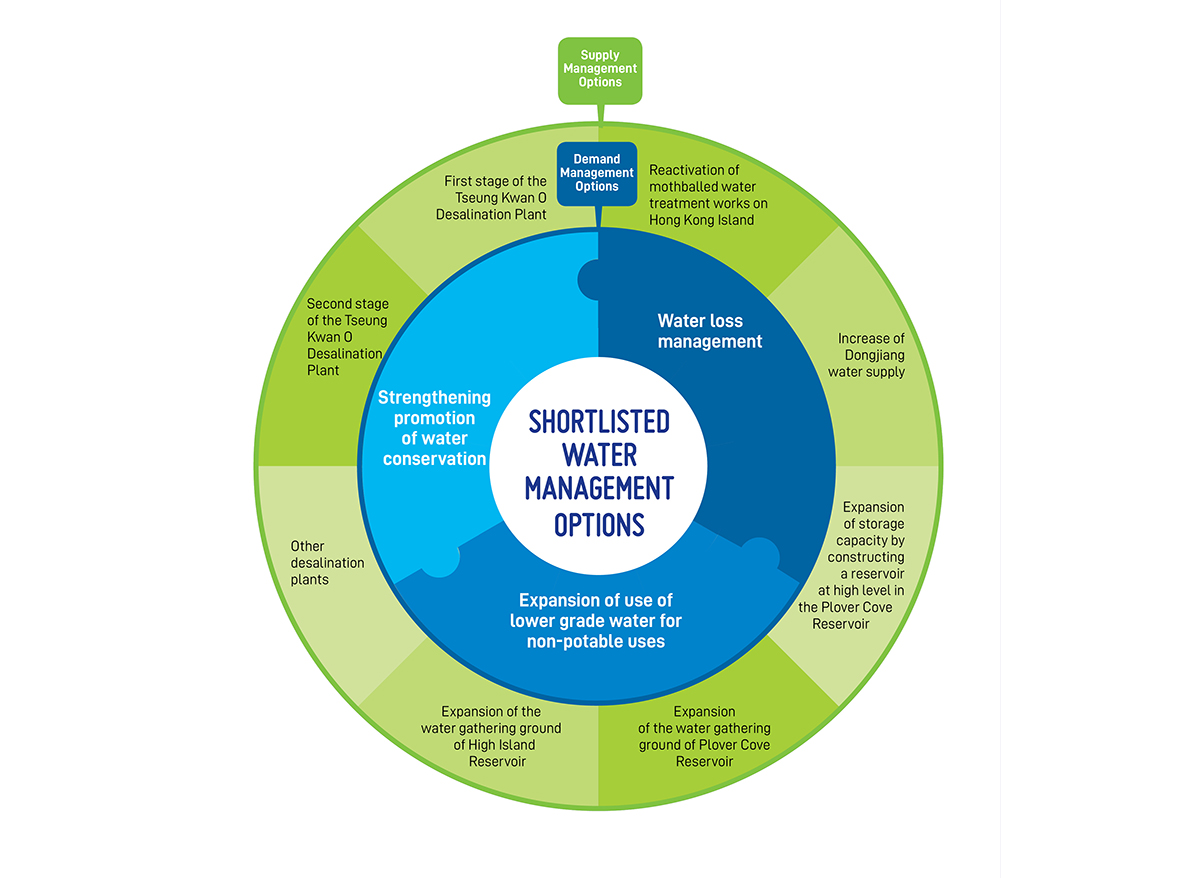
Based on the prioritised water management options, the updated Strategy (Strategy 2019) will adopt a two-pronged approach with emphasis put on containing fresh water demand growth and building resilience in the fresh water supply with diversified water resources, which is considered to be the most effective strategy.
As revealed in the Review, under the medium-low and medium-high greenhouse gas concentration scenarios with mean annual rainfall and the expected population growth scenario, the current water supply will be able to meet the forecast water demand when measures to contain the demand growth are implemented. We will therefore continue to implement the water demand management measures of water conservation, water loss management and expansion of the use of lower grade water (i.e. seawater and recycled water) for non-potable purposes.
We have also worked out the water supply management measure for building resilience in the fresh water supply to cater for the lower bound of the envelope of projected effect on local annual rainfall (and hence substantially reduced local yield) due to climate change, i.e. the first stage of desalination plant in Tseung Kwan O (TKO) to be commissioned in 2023 to supply desalinated water.
Furthermore, a list of backup options is recommended in case the situation had deviated from the present projections due to reasons such as higher-than-expected population growth, worse-than-projected impact of climate change on rainfall or less-than-anticipated effect of containing water demand growth.
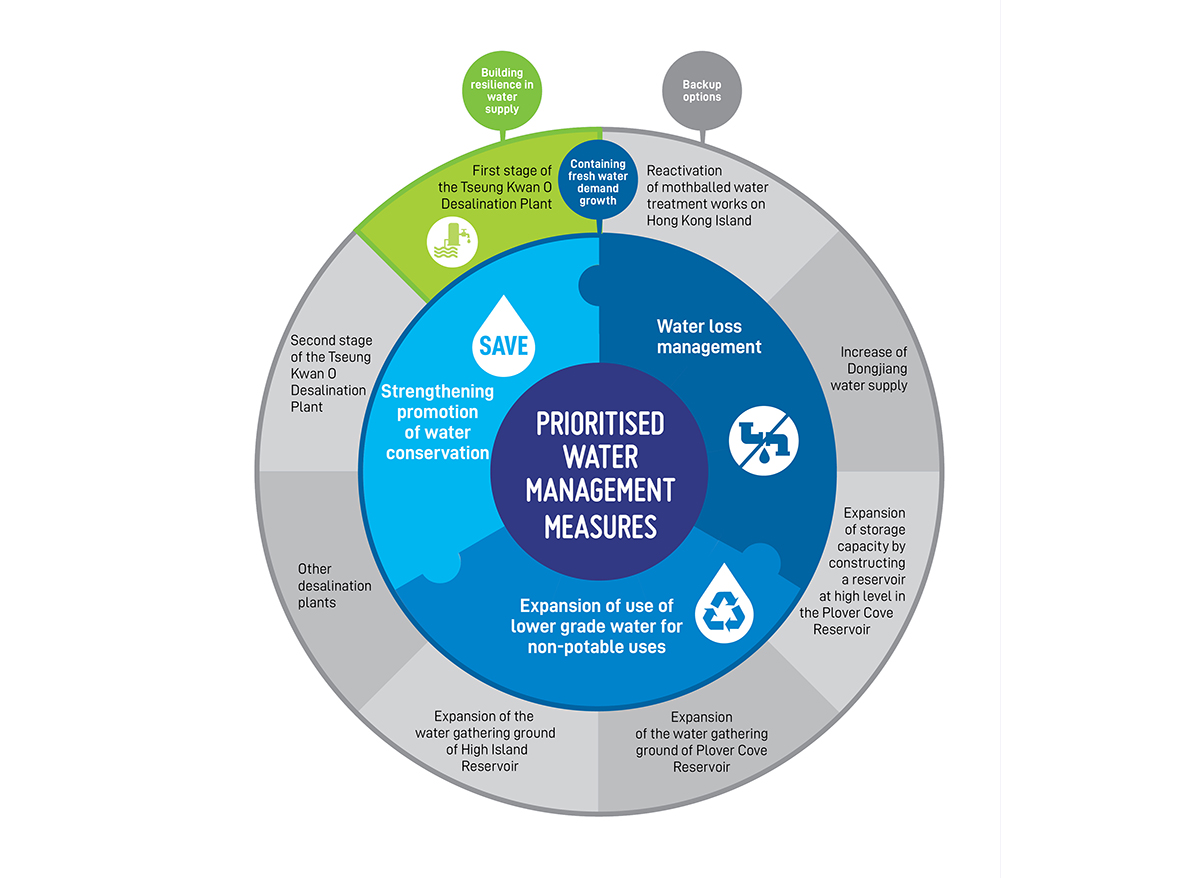
Notes:-
| 8. | Projected effect on annual rainfall refers to the projected annual rainfall anomaly of Hong Kong relative to the average of 1986-2005 under different greenhouse gas concentration scenarios by the Hong Kong Observatory. |
| 9. | Reliable local water supply refers to the contribution of local yield and reservoir storage under extreme drought condition with a return period of one in 100 years. |